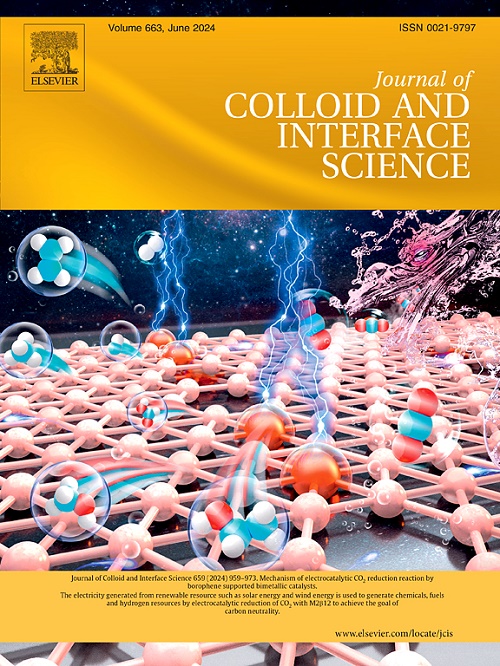从掺钒磷化镍/偏磷酸盐中原位重组镍(III)基活性位点,实现大电流密度下超稳定尿素辅助水电解。
IF 9.4
1区 化学
Q1 CHEMISTRY, PHYSICAL
引用次数: 0
摘要
利用含尿素废水电解制氢急需高效的氧进化反应(OER)和尿素电氧化反应(UOR)双功能电催化剂。主要的挑战在于 UOR 动力学的迟缓以及催化剂在实际高电流密度下的稳定性。本文成功合成了掺钒的具有蓬松纳米片状形态的 Ni(PO3)2/Ni2P 异质结构。在磷化过程中,掺杂钒原子促进了 Ni(PO3)2/Ni2P 异质结的形成。研究表明,在 OER 和 UOR 过程中,掺杂 V 原子的 Ni(PO3)2/Ni2P 能加速生成真正的活性位点 V@NiOOH,而 PO3- 离子也能使其稳定。原位形成的 V@NiOOH 增加了尿素分子的吸附能,降低了关键中间产物 *COO 的吸附能,从而促进了 CO2 产物从催化剂表面的释放。*HNCON 到 *NCON 的能障也大大降低,促进了 UOR 的动力学。此外,蓬松的纳米片形态提供了大量的催化位点和传输通道,有利于在高电流密度下进行传质。因此,基于 V-Ni(PO3)2/Ni2P 电极的阴离子交换膜(AEM)电解槽在 550 mA cm-2 的工业级电流密度下,仅需 1.61 V 的电压就能驱动尿素的全电解,并具有 700 h 的出色耐久性。本文章由计算机程序翻译,如有差异,请以英文原文为准。

In-situ reconstitution of Ni(III)-based active sites from vanadium doped nickel phosphide/metaphosphate for super-stable urea-assisted water electrolysis at large current densities
Efficient bifunctional electrocatalysts towards oxygen evolution reaction (OER) and urea electrooxidation reaction (UOR) are urgently needed for hydrogen production from urea-containing wastewater electrolysis. The main challenge lies in the sluggish UOR kinetics and the stability of catalyst under practical high current density. Here, a vanadium doped heterostructure of Ni(PO3)2/Ni2P with shaggy nanosheet morphology was successfully synthesized. The doping of V atoms promotes the formation of Ni(PO3)2/Ni2P heterojunction in phosphating process. It is demonstrated that V-doped Ni(PO3)2/Ni2P accelerates the generation of real active site V@NiOOH in OER and UOR processes, which can also be stabilized by the PO3− ions. The in-situ formed V@NiOOH increases the adsorption energy of urea molecule, and reduces the adsorption energy of key intermediates *COO, thus facilitating the release of CO2 product from the catalyst surface. The energy barrier of *HNCON to *NCON is also reduced dramatically, promoting the kinetics of UOR. In addition, the shaggy nanosheets morphology provides large number of catalytic sites and transport channels, which are conducive to mass transfer under high current density. As a result, the V-Ni(PO3)2/Ni2P electrode based anion-exchange membrane (AEM) electrolyzer needs only 1.61 V to drive the total urea electrolysis at an industrial grade current density of 550 mA cm−2 with an outstanding durability of 700 h. This work paves the way for designing practical efficient and stable electrocatalyst for urea contained wastewater electrolysis to produce hydrogen.
求助全文
通过发布文献求助,成功后即可免费获取论文全文。
去求助
来源期刊
CiteScore
16.10
自引率
7.10%
发文量
2568
审稿时长
2 months
期刊介绍:
The Journal of Colloid and Interface Science publishes original research findings on the fundamental principles of colloid and interface science, as well as innovative applications in various fields. The criteria for publication include impact, quality, novelty, and originality.
Emphasis:
The journal emphasizes fundamental scientific innovation within the following categories:
A.Colloidal Materials and Nanomaterials
B.Soft Colloidal and Self-Assembly Systems
C.Adsorption, Catalysis, and Electrochemistry
D.Interfacial Processes, Capillarity, and Wetting
E.Biomaterials and Nanomedicine
F.Energy Conversion and Storage, and Environmental Technologies

 求助内容:
求助内容: 应助结果提醒方式:
应助结果提醒方式:


